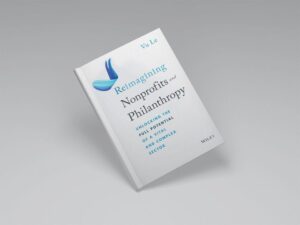
Editors’ note: This article is from NPQ’s summer 2015 edition, “Nimble Nonprofits: The Land of the Frugal Visionary.”
Let’s imagine that a deep-pocket donor hears something truly fabulous (and well deserved) about your after-school program. Not only did that donor grow up in the area and have an attachment to it, she is also deeply concerned about the new generation of children growing up in the neighborhood and facing twenty-first century challenges. She decides on a whim to look you up on GuideStar. What does she find?
If you are lucky, she finds up-to-date financials—and by up to date, we mean less than three years old. The financials, however, contain some unexplained quirks. Perhaps one year the operation looks flush and the next it looks like it is losing money hand over fist. Nowhere are these quirks explained, because your Form 990 is up there all by its lonesome. She could do some further research, but if you can’t be bothered to place your information on the most widely used resource for information about U.S. nonprofits, then why should she go looking for it?
This problem has a quick fix, and that is to use the space GuideStar offers to nonprofits to explain their programs, clarify information in their 990s, and otherwise inform potential donors (and others who may be interested in you).
Each of the over two million nonprofit organizations in GuideStar’s database has a profile—a page on its site devoted entirely to the organization so that people can access in-depth information about it. Most of these profiles present data that the organizations have submitted to the IRS. IRS information, however, doesn’t always give a complete or timely picture of your nonprofit to GuideStar’s thirty-five thousand daily visitors—and we’re not even counting the thousands more who access the information via a growing series of application programming interfaces (APIs) that GuideStar has created over the last two years.
When you take the time to update your profile on GuideStar, you’re demonstrating your organization’s commitment to transparency and communicating directly with its stakeholders through GuideStar and GuideStar’s vast data distribution network—for free.
The Limitations of Depending on Your 990 to Tell Your Story
We all know that it takes too long for a nonprofit’s Form 990 information to become available to the public—through www.guidestar.org or elsewhere—after it has been filed with the IRS. As a result, our nation’s social change makers are looking at information that is often more than a year old. We also know that making decisions about philanthropy by relying solely on a Form 990 is problematic, because the information provided on that form is limited. The IRS didn’t develop those data fields for the purpose of evaluating nonprofit effectiveness; in truth, they were designed simply to help the IRS determine whether nonprofits are in compliance with the laws governing exempt organizations. In addition, just under half of nonprofits file the 990-N, which has only eight questions, and public academic institutions (because they are government entities) and faith-based organizations aren’t required to file at all. So when individuals and others look to the 990 to decide where to give their money and time, they’re not even working with the right kind of information.
What Makes Up the GuideStar Nonprofit Profile?
In the same way that updating your personal Facebook and LinkedIn profiles gives you a way to communicate directly with all the people in your life at the same time, updating your GuideStar Nonprofit Profile ensures that millions of prospective donors and funders will find accurate, timely information about your organization. In fact, your information is seen by more than seven million people who access GuideStar data each year, and then by millions more as your information travels through GuideStar’s data-distribution network.
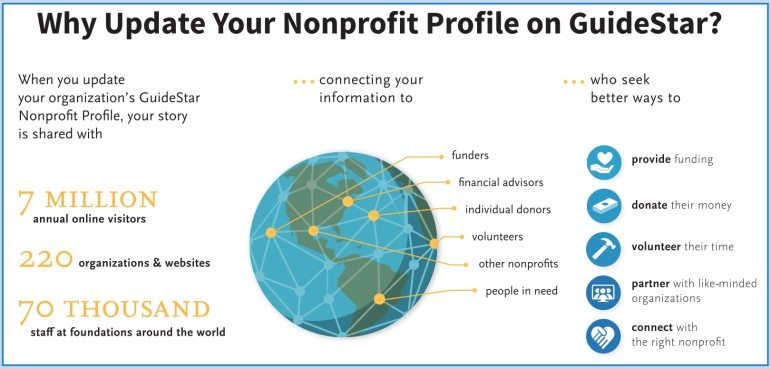
Four Great Reasons to Update Your GuideStar Nonprofit Profile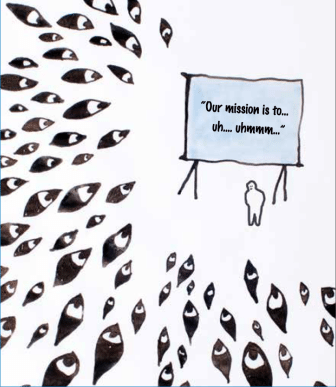 1. Take charge of your organization’s online identity.You have the power to choose what millions of people see about your organization each year. Providing the public with your most up-to-date and complete information means that you are sharing your organization’s true story. You get your most up-to-date information in front of GuideStar’s millions of users as well as visitors to more than 220 other websites, applications, and platforms, including AmazonSmile, JustGive, Network for Good, VolunteerMatch, dozens of online giving portals, all major U.S.- based donor-advised funds, thousands of foundations such as the California Endowment, more than sixteen leading community foundations, and more. 2. Increase funding.Updating your organization’s profile on GuideStar gives you the opportunity to increase funding and visibility for your organization:
3. Save time with your grant applications.Grant applications can be prepopulated with information that nonprofits have already updated in their GuideStar Nonprofit Profile. In support of the Simplify initiative, this process uses the existing central database of nonprofit information to eliminate the repetitive elements of grant applications and enable more efficient grantmaking.1 GuideStar is working with nine of the largest grants-management software vendors to add this functionality; it will be fully functional with at least two of the vendors by the end of this year. 4. Don’t spend a dime.Updating your GuideStar Nonprofit Profile is free. |
How to Update Your GuideStar Nonprofit Profile
- Go to guidestar.org/update.
- Click on the blue “Get started now” button at the top of the page.
- Sign into your account (use your registered e-mail address and password)—or, if you don’t have an account, create one.
- When you are signed in, you should see your organization listed on the page. Click on your organization’s name. If you do not see your organization’s name, you must request permission to manage your organization’s profile.
- To request permission, enter your organization’s Employer Identification Number (EIN), click on the “Request permission” button, enter the required fields, and submit your request. Your request will be approved in one to two business days.
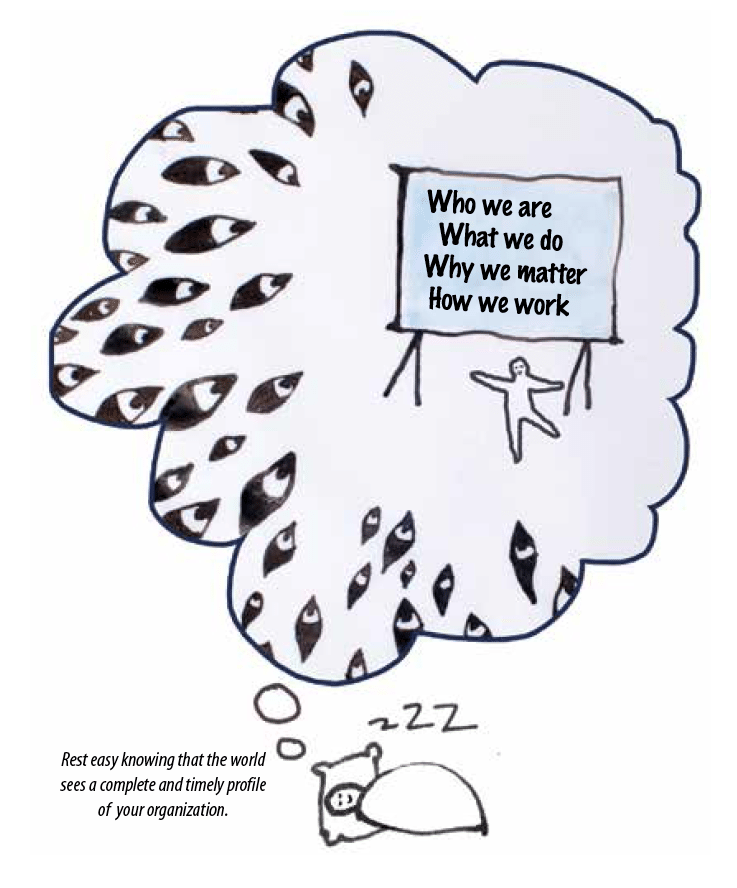
GuideStar’s Role
GuideStar exists to help people make more intelligent decisions within the social sector. That all starts with better data about nonprofits. Nonprofits are better positioned than anyone else to tell their own story. Our job is to take that data and amplify it. In the end, it’s the people, communities, and ecosystems served by the nonprofits that will benefit.
—Jacob Harold, GuideStar’s president and CEO
GuideStar is the only organization that encourages nonprofit transparency on a national scale and allows nonprofits to supplement the public information that is available from the IRS. From the launch of its first website, in October 1996, GuideStar has provided nonprofits with a way to update their information in its database. Then, as now, the goal was to give nonprofits a platform through which they could tell their full stories, enabling them to go beyond basic IRS and Form 990 data and share information about their missions, programs, leadership, needs, and accomplishments. Organizations could update as often as they wished, allowing them to provide more current information than what is available in IRS records.
In late 2007, GuideStar launched the second generation of its program and named it the GuideStar Exchange;2 after extensive conversations with nonprofits, foundations, and other key users of their data, GuideStar revised the information collected from the organizations. GuideStar also introduced functionality that allowed nonprofits to increase their transparency by posting their applications for exemption, IRS letters of determination, audited financial statements, and most recent Form 990s to their profiles. Although GuideStar has continued to refine the GuideStar Exchange over the last eight years, the goal has remained the same: to allow nonprofits to provide meaningful information in an ongoing way so that the millions of people who use GuideStar data every year—and the millions more who visit the sites of GuideStar’s data-distribution network—have a more complete and accurate picture of those organizations.
Sign up for our free newsletters
Subscribe to NPQ's newsletters to have our top stories delivered directly to your inbox.
By signing up, you agree to our privacy policy and terms of use, and to receive messages from NPQ and our partners.
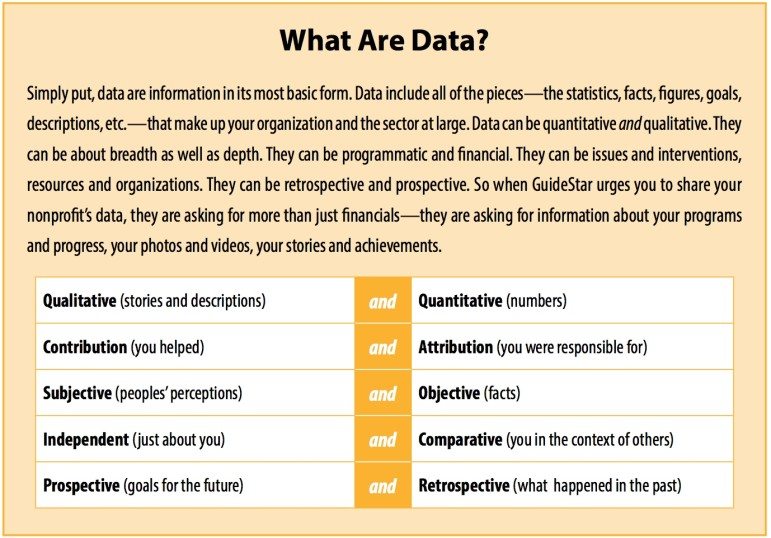
Who Participates?
To date, more than 110,000 nonprofits have provided GuideStar with some level of information by updating their profiles, including more than forty-two thousand nonprofits that have reached the Bronze, Silver, or Gold participation level. Since June 2013 alone, nonprofits have shared millions of data points through this process. This nonprofit-provided information is combined with Form 990 and other IRS data to create a much more complete picture of a nonprofit’s operations, programs, and results. Organizations can also update their information on GuideStar at any time and know that millions of people will see their most up-to-date information long before the IRS releases it. Keeping information current means that people inside and outside the nonprofit sector know they are accessing the most reliable and complete picture of an organization.
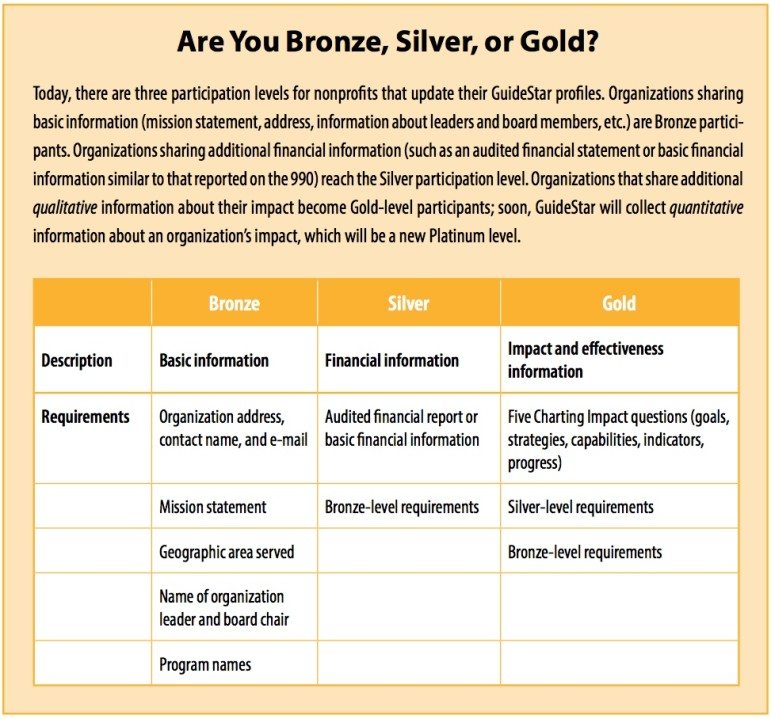
The Evolution of a Common Profile
Of course, GuideStar recognizes that the sector changes. There are shifts in the kinds of information people are looking for. New best practices emerge. Thus, the information GuideStar collects from nonprofits in their reports has adapted and will continue to evolve with the sector as well. One aspect of GuideStar’s efforts has never changed and never will: Allowing nonprofits to provide their most complete and up-to-date information is about empowering nonprofits to tell their full stories to the nonprofit universe. Self-reported information and transparency are the cornerstones of this program.
However, two major developments are coming to GuideStar Nonprofit Profiles over the next few months. First, the online interface where nonprofits update their profile information is getting a facelift to provide a more streamlined user experience. The goal of the redesign is to make it easier and more intuitive for nonprofits to update their profiles, track their progress, and reach each participation level; another potential feature of the redesign will be to make the interface mobile responsive, in order to make it easier for nonprofits to update their profiles in our increasingly mobile 2015 world.
Second, one of the bigger behind-the-scenes projects at GuideStar right now is an overhaul of the way information appears on an organization’s GuideStar Nonprofit Profile. The redesign will leverage GuideStar’s wealth of historical nonprofit information and will group information into sections that will tell each nonprofit’s story more clearly. The new profile pages will include a range of interactive data visualizations that can help users make sense of the complex nonprofit information that drives decision making in the social sector.
For the good of the sector, GuideStar is continually evolving its Nonprofit Profiles to promote widespread adoption. GuideStar works with a variety of partners—including BoardSource, Independent Sector, BBB Wise Giving Alliance, D5 Coalition, Green 2.0, the Cultural Data Project, and others—to ensure that the profile is multidimensional, nonduplicative of other reporting efforts, and useful for a wide variety of stakeholders. For example:
- In March 2014, GuideStar and BoardSource announced a new initiative that enabled nonprofits to share information about how their organizations are governed, shedding light on a critical indicator of organizational strength and stability that is often hidden from public view. To date, more than two thousand nonprofits have provided this level of detail.
- In May 2011, GuideStar partnered with BBB Wise Giving Alliance and Independent Sector to launch an initiative called Charting Impact, a standard framework for creating reports that enable stakeholders to easily and clearly understand the objectives, benchmarks for progress, and impact of nonprofits and foundations. This sector-wide initiative was developed by nearly two hundred leaders to help organizations of all types, sizes, and missions convey their efforts to advance the common good, thus establishing an industry standard for reporting in-depth mission objectives and results. The cornerstone of Charting Impact is a series of five questions that encourage strategic thinking and the open sharing of ideas, strategies, and results within the nonprofit community. To reduce the information-sharing burden on nonprofits, in August 2013 Charting Impact was integrated into the GuideStar Exchange program. Organizations that answer the five Charting Impact questions reach the Gold participation level, which to date has been accomplished by more than six thousand organizations.
GuideStar Collects Diversity DataWithout sector-wide standards for how data on diversity is collected, nonprofits and foundations have had difficulty identifying trends, gaps, overlaps, and opportunities. More comprehensive diversity information across the sector is needed to help foundations better understand their constituencies. Higher-quality diversity information is also needed for nonprofits to better evaluate the impact of their work and hold them To help bridge this gap, in October 2014 GuideStar launched a first-of-its-kind program to collect diversity data from nonprofits on a national scale. The voluntary program is helping to set standards for how data about diversity within the social sector is collected. GuideStar worked in collaboration with the D5 Coalition, which developed the standards with a wide range of partners to advance transparent and uniform data collection about staff, board, and volunteer demographics in the nonprofit and philanthropic sectors, enabling more informed decisions about philanthropy. The launch also coincided with a pilot partnership between Green 2.0, which collaborated with GuideStar, and D5 to seek participation from environmental organizations in this groundbreaking diversity-tracking effort. This is in response to the problematic “green ceiling”—the mainstream environmental movement’s failure to keep up with the changing face of America, which was documented in The State of Diversity in Environmental Organizations: Mainstream NGOs, Foundations & Government Agencies, a report commissioned by Green 2.0 from Professor Dorceta Taylor.3 Green 2.0’s working group advocates for improved diversity in the mainstream environmental movement. Since the launch of the initiative, close to three thousand nonprofits nationwide (including more than seventy-five top environmental advocacy nonprofits) have submitted diversity data to GuideStar. |
• • •
Let’s imagine once again that the deep-pocket donor hears something truly fabulous and well deserved about your after-school program. This time, when the donor visits GuideStar she finds information that explains the various pieces of your more up-to-date 990, and she also reads all about the impact you’ve made in the past year. Do you think she gives you money? We’re willing to bet she does—or at the minimum, that she reaches out to start a conversation about something on your GuideStar Nonprofit Profile. GuideStar gives you a great way to maximize your organization’s reach and impact with just a few clicks of a button, and it’s free. So what are you waiting for? Go maximize your real estate!
One Foundation’s Experience Using GuideStar Nonprofit Profile InformationDolores Estrada is manager of grants administration at The California Endowment. When in 2010 The California Endowment decided to transition to a ten-year, $1 billion comprehensive community initiative, they decided as part of the initiative to reduce the “In doing so,” Dolores explained, “we needed a solution that would allow us to have access to essential information for our decision making as well as an external (cloud) repository of information. Integrating the GuideStar Nonprofit Profile into the organization’s application process helped us to create a cost-efficient workflow that allowed us to process proposals in less time while having an outside repository of the data needed for decision making. Using GuideStar has helped our grantmaking workflow. It has significantly helped to reduce the turnaround time from intake to award process—from 120 days to under fifty-five days. “In addition, GuideStar has been a great partner by paying attention to the field’s needs and developing tools that make the ‘how’ of grantmaking more focused. Most important, it has provided excellent customer service to both The California Endowment as a client and The California Endowment’s grantees as users of its Nonprofit Profile information.” |
Notes
- To learn more about the Simplify initiative, visit simplifynow.org.
- To learn more about GuideStar Nonprofit Profiles, visit guidestar.org/update.
- Dorceta E. Taylor, The State of Diversity in Environmental Organizations: Mainstream NGOs, Foundations & Government Agencies.
Lindsay J. K. Nichols is America’s Charities’ vice president of marketing and communications. Gabe Cohen is GuideStar’s media and outreach manager. Ruth McCambridge is the Nonprofit Quarterly’s editor in chief.






